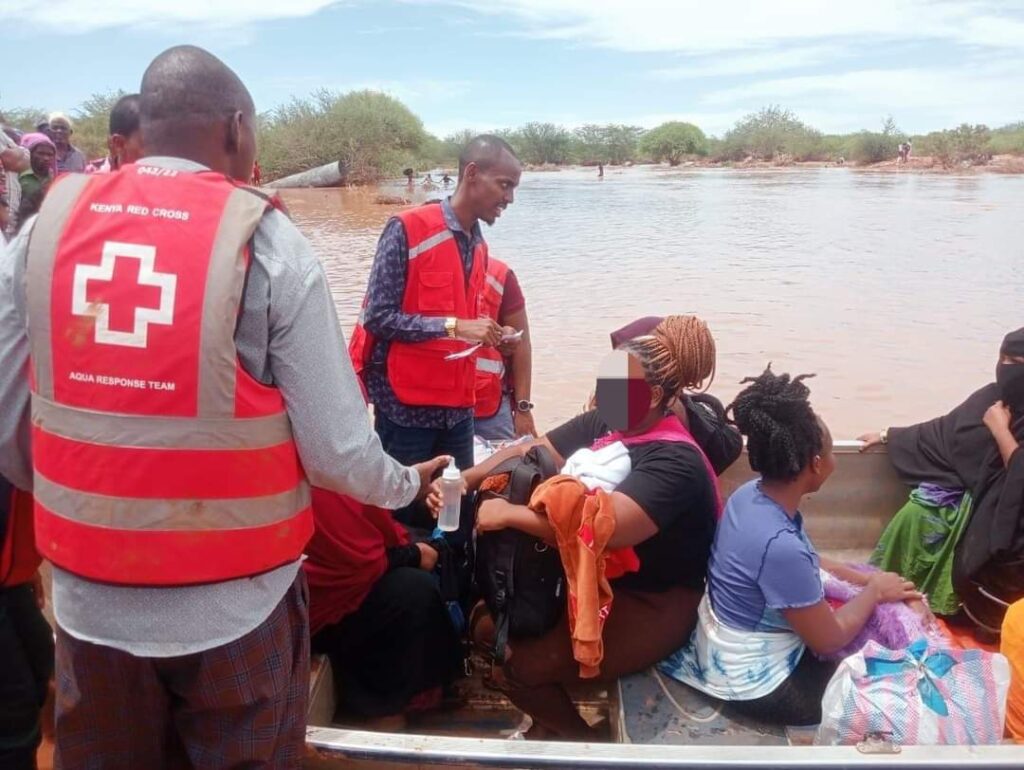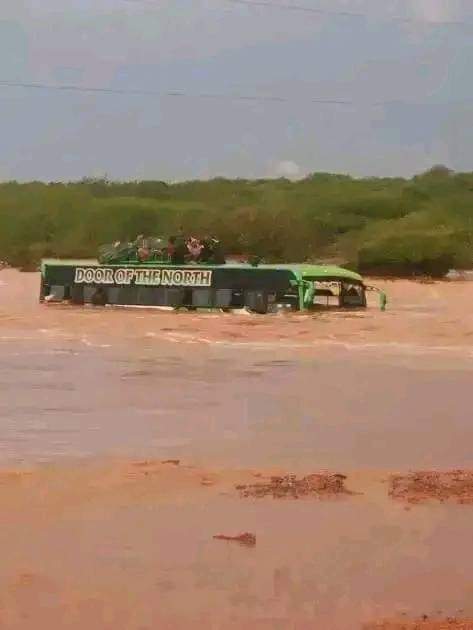A PSV bus with 51 passengers has been swept away by raging floods on the Garissa-Nairobi Highway.The incident that occurred on the early hours of Tuesday, April 9 saw the vehicle, belonging to the Umma Express Bus Company, swept away by floods at Chuma area.


A report says that upon reaching the location, the driver of the bus, Hassan Turbo, attempted to cross the flooded section of the road following a heavy downpour.Unfortunately, the bus slipped out of the road and got stuck into a ditch. As a result, the bus was slowly swept by the water and got stuck 30 metres off the highway.
The Umma Bus incident on the Tula Bridge stands as a stark reminder of the unpredictable and devastating force of natural disasters. On a routine journey from Wajir to Nairobi, tragedy struck as heavy floods swept away the bus, leaving 51 passengers onboard. This incident not only highlights the vulnerability of transportation infrastructure to extreme weather events but also underscores the importance of preparedness, response, and resilience in the face of such calamities. In this essay, we will delve into the details of the incident, examine its causes and consequences, analyze the response efforts, and explore lessons that can be learned to prevent similar tragedies in the future.
The Incident:
On 9th April, a bus belonging to Umma Express Limited embarked on its journey from Wajir, a town in northeastern Kenya, to Nairobi, the capital city. The bus, carrying 51 passengers, was en route when it encountered heavy rains and subsequent flooding at the Tula Bridge. As the floodwaters surged, they overwhelmed the bridge, sweeping away the bus along with its occupants. The suddenness and ferocity of the flood caught both the passengers and the bus operators off guard, leading to a tragic loss of lives.
Causes and Contributing Factors:
Several factors likely contributed to the severity of the incident. Firstly, the onset of heavy rains, possibly fueled by seasonal weather patterns or climatic anomalies, created conditions conducive to flooding. In regions like Wajir, which are prone to arid climates, sudden and intense rainfall can overwhelm the limited drainage systems, leading to flash floods. Poor infrastructure, including inadequately constructed bridges and culverts, may have exacerbated the situation by impeding the natural flow of water and increasing the likelihood of flooding.
Furthermore, the lack of early warning systems or real-time monitoring of weather conditions might have hindered the ability of authorities to anticipate and respond to the impending disaster. In remote areas like Wajir, where access to advanced meteorological data and communication networks may be limited, communities and transportation providers may not have received timely alerts about the potential risks of traveling during adverse weather conditions.
Response Efforts:
In the aftermath of the tragedy, emergency response teams, including local authorities, national disaster management agencies, and volunteer organizations, mobilized to conduct search and rescue operations. The challenging terrain and adverse weather conditions posed significant obstacles to these efforts, requiring specialized equipment and expertise to navigate through the flooded areas and locate survivors.
Additionally, efforts were made to provide medical assistance, temporary shelter, and support services to the affected families and communities. Counseling and psychosocial support were offered to those traumatized by the loss of loved ones or the harrowing experience of surviving the disaster. The government, in collaboration with humanitarian agencies and community leaders, initiated relief efforts to address the immediate needs of the survivors and mitigate the long-term impacts of the incident.
Lessons Learned and Recommendations:
The Umma Bus incident serves as a wake-up call for stakeholders at all levels to prioritize disaster preparedness, mitigation, and response strategies. Key lessons emerge from this tragedy, including the need for:
Improved Infrastructure: Investments in resilient infrastructure, including bridges, roads, and drainage systems, are essential to withstand extreme weather events and minimize the risk of flooding. Engineering designs should consider climate change projections and incorporate measures to enhance structural integrity and drainage capacity.
Early Warning Systems: The establishment of robust early warning systems, supported by advanced meteorological technology and community-based monitoring networks, can provide timely alerts and guidance to vulnerable populations and transportation providers. Public awareness campaigns and training programs should promote proactive measures for disaster preparedness and evacuation planning.
Coordination and Collaboration: Effective coordination among government agencies, emergency responders, civil society organizations, and local communities is critical for a coordinated and efficient response to disasters. Inter-agency cooperation, information sharing, and joint exercises can strengthen the capacity to manage crises and save lives.
Community Resilience: Building community resilience through education, training, and capacity-building initiatives empowers individuals and communities to anticipate, mitigate, and respond to disasters effectively. Disaster risk reduction strategies should be integrated into development planning processes, ensuring that vulnerable populations are prioritized and their voices heard.
The Umma Bus incident on the Tula Bridge stands as a tragic reminder of the devastating impact of natural disasters on transportation infrastructure and human lives. As we mourn the loss of those who perished in this tragedy, we must also redouble our efforts to prevent such incidents from recurring. By addressing the root causes of vulnerability, enhancing preparedness and response capabilities, and fostering collaboration and resilience within communities, we can build a safer and more resilient future for all. Let us honor the memory of the victims by learning from this tragedy and taking decisive action to protect lives and livelihoods in the face of adversity.
Strengthened Regulation and Enforcement: Governments and regulatory bodies should enforce strict standards and regulations for transportation safety, including vehicle maintenance, driver training, and adherence to weather-related travel advisories. Regular inspections and audits of transport operators can help identify and address potential risks before they escalate into disasters.
Climate Change Adaptation: Climate change adaptation measures, such as land-use planning, ecosystem restoration, and sustainable water management, are essential for reducing the frequency and severity of extreme weather events. Investing in climate-resilient infrastructure and promoting eco-friendly transportation options can contribute to mitigating the impacts of climate change on transportation networks and safeguarding the lives and livelihoods of vulnerable populations.
Enhanced Communication and Information Sharing: Improved communication channels and information-sharing platforms can facilitate timely dissemination of weather forecasts, road conditions, and emergency alerts to travelers and transportation providers. Utilizing mobile technology, social media, and community radio stations can reach remote and marginalized communities, enabling them to make informed decisions and take appropriate action during emergencies.
Continuous Learning and Adaptation: Reflecting on past experiences and lessons learned from disasters, stakeholders must engage in continuous learning and adaptation to evolving risks and challenges. Conducting post-disaster assessments, conducting simulation exercises, and incorporating feedback from affected communities can inform future policies and practices, fostering a culture of resilience and innovation in disaster management.
Incorporating these additional measures into comprehensive risk reduction strategies can help mitigate the vulnerabilities of transportation systems to natural disasters and protect the safety and well-being of passengers and personnel alike. By embracing a holistic and multi-sectoral approach to disaster risk management, we can build more resilient and sustainable transportation networks that withstand the impacts of climate change and ensure equitable access to safe and reliable mobility for all.
